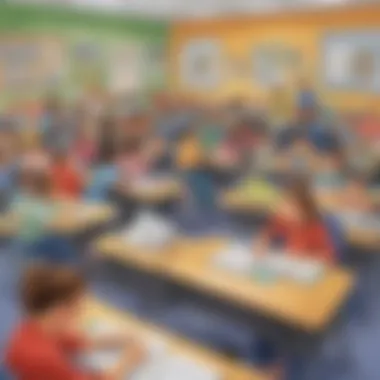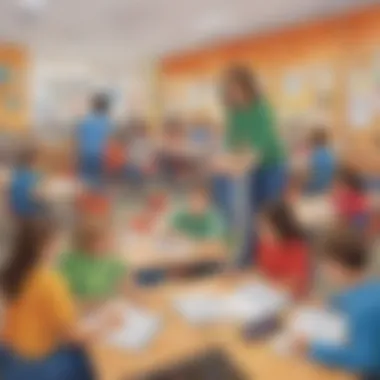Unlocking Effective Classroom Management: Essential Tools for Educators


Creative Activities
Effective classroom management involves integrating creative activities to engage students in a stimulating learning environment. By incorporating craft ideas that are easy to replicate, teachers can cultivate students' creativity and fine motor skills. Step-by-step guides detailing the instructions for each activity help teachers execute these tasks seamlessly, ensuring smooth implementation in the classroom. Moreover, discussing the educational value of these activities highlights how they contribute to cognitive development and academic enrichment.
Fun Quizzes
To make learning enjoyable and interactive, fun quizzes are a valuable resource for teachers. Covering a wide range of quiz topics, these engaging assessments on Elem Fun spark curiosity and promote knowledge retention among students. The variety of question types used in these quizzes cater to different learning styles, catering to both auditory and visual learners. Through these quizzes, students not only test their understanding of various subjects but also reinforce their knowledge, aiding in long-term retention.
Fact-Based Articles
Delving into fact-based articles expands students' horizons by introducing them to diverse topics. These articles present information in an engaging and easy-to-understand manner, enhancing students' comprehension and encouraging them to broaden their knowledge base. Additionally, incorporating additional resources such as related articles and external links further amplifies students' learning experience, allowing them to delve deeper into specific subjects of interest.
Introduction
Classroom management plays a pivotal role in the educational journey of students, representing the cornerstone of effective teaching practices. By establishing a well-structured and disciplined environment, teachers can cultivate an atmosphere conducive to optimal learning outcomes for their students. This section delves into the significance of classroom management, highlighting its essential role in shaping educational experiences and shaping student development.
Significance of Classroom Management
Creating a Conducive Learning Environment
Creating a conducive learning environment is paramount in fostering student engagement and academic success. It involves structuring the physical space and organizational flow of the classroom to promote focus and productivity among students. A well-designed learning environment enhances student concentration, facilitates seamless interaction, and encourages active participation, thereby maximizing the efficacy of teaching interventions.
Enhancing Student Engagement
Enhancing student engagement is a critical facet of effective classroom management. This involves implementing strategies that captivate student interest and motivation, making learning experiences dynamic and interactive. By fostering engagement, teachers can optimize knowledge retention, stimulate curiosity, and promote critical thinking skills essential for academic growth.
Promoting Positive Behavior
Promoting positive behavior is fundamental in maintaining a harmonious classroom atmosphere and nurturing students' social-emotional well-being. By instilling behavioral expectations, reinforcing positive actions, and implementing reward systems, teachers can encourage a culture of respect, responsibility, and mutual support within the classroom. This not only diminishes disruptions but also fosters a sense of community and belonging among students.
Impact on Student Performance
Academic Achievement


Enhancing academic achievement through effective classroom management strategies is instrumental in elevating student learning outcomes. By setting clear academic goals, providing tailored support, and implementing structured learning activities, teachers can optimize students' academic progress and performance. Aligning teaching practices with individual learning needs promotes academic success and cultivates a growth mindset conducive to continuous improvement.
Emotional Well-being
Enhancing students' emotional well-being through classroom management interventions is indispensable for nurturing their holistic development. Addressing emotional needs, creating a safe space for self-expression, and promoting emotional regulation skills contribute to students' overall well-being and mental health. By fostering emotional intelligence and empathy, teachers play a crucial role in shaping students' resilience and adaptive coping mechanisms.
Social Development
Facilitating social development through classroom management initiatives is essential for fostering students' interpersonal skills and collaborative abilities. By promoting teamwork, communication, and conflict resolution within the classroom setting, teachers empower students to navigate social interactions effectively. Cultivating a supportive and inclusive social environment nurtures empathy, cultural appreciation, and diverse perspectives among students, preparing them for success in an interconnected world.
Establishing Effective Routines
Establishing effective routines is a crucial aspect of classroom management, playing a pivotal role in creating a structured and organized learning environment. By implementing well-thought-out routines, teachers can optimize time management, enhance predictability for students, and establish a sense of security and stability within the classroom setting. Effective routines also contribute significantly to promoting student responsibility and independence, elements essential for long-term academic success. Educators must carefully consider elements such as consistency, clarity, and flexibility when designing routines to ensure their efficacy and positive impact on classroom dynamics.
Morning Routines
Morning routines are key to setting a positive tone for the day ahead, starting with essential tasks like taking attendance. Efficient attendance taking enables teachers to track student presence, identify patterns of behavior or absenteeism, and maintain accurate records crucial for administrative purposes. It instills a sense of accountability in students regarding their attendance and punctuality, fostering discipline and a habit of responsibility early in the day. Despite its straightforward nature, attendance taking stands as a fundamental element in establishing a structured and efficient classroom environment.
Setting the Tone for the Day
Setting the tone for the day involves creating a welcoming and engaging atmosphere that primes students for productive learning experiences. This includes activities like morning greetings, agenda sharing, or engaging icebreakers to energize and motivate learners from the onset. Setting a positive tone not only enhances student morale and enthusiasm but also establishes a culture of collaboration and respect within the classroom. It acts as a catalyst for learning, boosting student engagement and participation, and fostering a sense of community among peers and with the teacher.
Transitional Routines
Transitional routines are instrumental in effectively managing the flow of activities throughout the school day, ensuring smooth transitions between tasks and minimizing disruptions. Organizing materials in advance streamlines the transition process, reducing downtime and keeping students focused on learning objectives. Furthermore, facilitating seamless transitions between activities promotes efficiency and maximizes instructional time, optimizing the overall learning experience for students. By prioritizing transitional routines, educators can cultivate a sense of purposeful momentum and rhythm in classroom dynamics.
Transitioning Between Activities
Transitioning between activities requires strategic planning and synchronization to maintain student engagement and momentum. Effective transitions involve clear instructions, time management strategies, and smooth logistical arrangements to facilitate a seamless shift from one task to another. Consistent and well-executed transitions contribute to a cohesive learning environment, preventing disruptions and fostering a sense of continuity in the educational process. Efficient transitioning strategies not only enhance classroom management but also exemplify effective instructional practices that model organization and attentiveness.
End-of-Day Routines
End-of-day routines are designed to bring closure to the day's activities, reinforce learning objectives, and prepare students for the following day’s lessons. Reviewing the day's events allows for reflection and consolidation of learning, reinforcing key concepts and promoting retention. It offers an opportunity for students to self-assess their understanding and progress, encouraging metacognitive skills and fostering a sense of achievement. Preparing for tomorrow involves setting expectations, previewing upcoming activities, and organizing materials in readiness for the next school day, ensuring a smooth transition and efficient start to the morning. Engaging in these end-of-day routines marks a structured conclusion to the learning day, ensuring that students leave the classroom feeling supported, accomplished, and well-prepared for future academic endeavors.


Utilizing Technology in Classroom Management
Utilizing technology in classroom management is a crucial aspect of modern educational practices. Teachers can greatly benefit from incorporating digital tools to streamline their daily activities and enhance student engagement. By integrating technology effectively, educators can optimize time management and resource utilization, ultimately leading to a more efficient learning environment. The utilization of technology also allows for diversified approaches to teaching, catering to individual student needs and promoting interactive learning experiences.
Digital Tools for Organization
Gradebook Apps
Gradebook apps offer teachers a comprehensive platform to manage student data, track progress, and generate reports efficiently. The key characteristic of gradebook apps is their user-friendly interface that simplifies the input and retrieval of student information, grades, and attendance records. Teachers find gradebook apps beneficial due to their ability to provide real-time updates on student performance, facilitating timely interventions and personalized support. While gradebook apps enhance organizational efficiency, some educators may find them restrictive in customization options or data visualization capabilities.
Lesson Planning Software
Lesson planning software plays a vital role in designing curriculum, creating engaging lesson plans, and aligning teaching strategies with learning objectives. The standout feature of lesson planning software is its integration of multimedia elements, interactive content, and assessment tools to diversify instructional approaches. This software is a popular choice for teachers seeking to enhance classroom interactivity and differentiate instruction based on student abilities. The advantages of lesson planning software include improved lesson visualization, collaborative planning opportunities, and seamless integration of varied teaching resources. However, some educators may encounter challenges with the learning curve of mastering the software or adapting to frequent updates.
Engagement Platforms
Interactive Whiteboards
Interactive whiteboards revolutionize classroom interactions by enabling dynamic multimedia presentations, interactive lessons, and real-time feedback mechanisms. The key characteristic of interactive whiteboards is their ability to transform traditional lectures into engaging visual experiences that cater to diverse learning styles. Educators appreciate interactive whiteboards for their versatility in delivering interactive content, fostering student participation, and fostering critical thinking skills. While interactive whiteboards are recognized for enhancing classroom engagement, some educators might face technical issues or connectivity constraints that inhibit seamless integration.
Online Discussion Forums
Online discussion forums serve as virtual platforms for asynchronous communication, collaborative learning, and knowledge sharing among students. The key aspect of online discussion forums is their facilitation of peer-to-peer interactions, reflective discussions, and extended dialogue beyond classroom hours. Educators recognize online discussion forums as valuable tools for promoting student collaboration, encouraging critical thinking, and developing digital communication skills. The benefits of online discussion forums include increased student engagement, enhanced communication proficiency, and opportunities for broader knowledge exchange. However, educators may encounter challenges in monitoring forum participation, ensuring respectful interactions, and addressing technical glitches effectively.
Behavior Management Strategies
Behavior management is a critical component of effective classroom management, ensuring a productive and conducive learning environment for students. By implementing sound behavior management strategies, teachers can maintain order, foster positive relationships, and enhance overall student performance. In this section, we will delve into specific elements, benefits, and considerations surrounding behavior management strategies to provide a comprehensive guide for educators.
Positive Reinforcement Techniques
Positive reinforcement techniques play a pivotal role in shaping student behavior and promoting a positive learning atmosphere. Within this category, we will explore two key aspects: Reward Systems and Verbal Praise.
Reward Systems


Reward systems are designed to acknowledge and reinforce desirable behaviors in students, creating a motivation loop for continued positive conduct. The key characteristic of reward systems lies in their ability to incentivize students to strive for excellence through tangible or intangible rewards, such as stickers, tokens, or praise. Its effectiveness stems from the immediate gratification students receive, encouraging repetition of desired behaviors. While reward systems can foster a positive classroom culture and boost students' self-esteem, one downside is the risk of over-reliance on external rewards, potentially diminishing intrinsic motivation.
Verbal Praise
Verbal praise serves as a simple yet powerful form of positive reinforcement that can significantly impact student behavior and motivation. The primary attribute of verbal praise is its immediacy and personal touch, offering students direct recognition for their efforts and achievements. It is a popular choice for its accessibility and effectiveness in reinforcing desired behaviors without the need for material rewards. The unique feature of verbal praise lies in its ability to build students' self-confidence and cultivate a supportive classroom environment. However, excessive or insincere praise may lead to devaluation of its impact, requiring teachers to employ praise selectively to maintain its effectiveness.
Conflict Resolution Methods
Conflict resolution methods equip teachers with the tools to handle disputes and maintain a harmonious classroom atmosphere. Within this realm, we will discuss two crucial approaches: Mediation and Restorative Circles.
Mediation
Mediation involves a neutral third party facilitating communication and negotiation between conflicting parties to reach a mutually acceptable resolution. Its key characteristic lies in providing a structured framework for conflicting parties to express concerns, listen actively, and work towards a collaborative agreement. Mediation is a beneficial choice for addressing conflicts as it promotes empathy, active listening, and problem-solving skills among students. The unique feature of mediation is its potential to restore relationships and promote long-term conflict resolution skills. Nevertheless, challenges may arise in cases where parties are resistant to compromise or when underlying power dynamics complicate the mediation process.
Restorative Circles
Restorative circles are community-based approaches that emphasize open dialogue, empathy, and understanding to repair harm and restore relationships post-conflict. The principal aspect of restorative circles is their ability to foster a sense of community, belonging, and accountability within the classroom. They are a popular option for promoting emotional intelligence, conflict resolution, and empathy among students. The distinct feature of restorative circles is their focus on repairing harm and rebuilding trust through collective participation and dialogue. However, implementing restorative circles effectively requires time, commitment, and skill in facilitating reflective discussions and ensuring all voices are heard for genuine resolution.
Collaborating with Parents and Administrators
In the realm of effective classroom management, the aspect of collaborating with parents and administrators emerges as a pivotal element for teachers seeking to cultivate a thriving educational environment. By fostering strong partnerships with parents and working closely with school administrators, educators can create a cohesive support system that enhances student learning outcomes and overall classroom dynamics. Collaboration with parents ensures that teachers have access to valuable insights into each student's individual needs and behaviors outside the classroom, enabling a more personalized approach to instruction. Simultaneously, working alongside administrators allows teachers to align their classroom strategies with school-wide goals and policies, promoting consistency and coherence across the educational landscape. Therefore, the collaboration with parents and administrators is not just advantageous but essential for maintaining a holistic and effective educational ecosystem.
Communication Strategies
Regular Updates
Within the realm of communication strategies, the practice of providing regular updates plays a crucial role in fostering transparency and keeping all stakeholders informed about significant developments and progress within the educational setting. Regular updates serve as a mechanism for ensuring that parents, caregivers, and school administrators are kept abreast of students' academic achievements, behavioral milestones, and any pertinent changes in classroom routines. By maintaining open channels of communication through consistent updates, teachers can establish trust and credibility with parents and administrators, demonstrating a commitment to fostering meaningful partnerships in support of student success. The key characteristic of regular updates lies in its ability to promote parental involvement and engagement in the educational journey, offering a comprehensive overview of each student's academic progress and behavioral patterns. This approach not only facilitates proactive interventions when necessary but also cultivates a sense of community and collaboration within the educational framework.
Parent-Teacher Conferences
As an integral part of effective communication strategies, parent-teacher conferences represent a cornerstone in establishing meaningful connections between educators, parents, and caregivers. These conferences provide a dedicated platform for discussing students' progress, addressing concerns, setting academic goals, and strategizing collaborative efforts to support each child's educational development. The key characteristic of parent-teacher conferences lies in their ability to facilitate in-depth conversations that go beyond typical progress reports, allowing for personalized insights into a student's strengths, areas for improvement, and holistic development. By fostering a direct dialogue between teachers and parents, these conferences promote a shared responsibility for students' learning outcomes and create a sense of unity in working towards common educational objectives. Additionally, parent-teacher conferences offer an opportunity to celebrate accomplishments, address challenges, and align on strategies for continued growth and success, making them an invaluable component of effective classroom communication.
Professional Development Opportunities
Workshops
In the realm of professional development opportunities, workshops stand out as immersive experiences that offer teachers practical insights, pedagogical strategies, and collaborative learning environments to enhance their instructional practices and classroom management techniques. Workshops provide educators with a forum to engage with diverse perspectives, share best practices, and acquire new skills that can be directly applied to their teaching approach. The key characteristic of workshops lies in their hands-on nature, allowing teachers to participate in interactive sessions, explore innovative teaching methods, and receive immediate feedback on their pedagogical implementation. This immersive learning experience not only enriches teachers' knowledge base but also fosters a sense of camaraderie and continuous growth within the educational community. By actively participating in workshops, educators can stay abreast of the latest educational trends, refine their instructional strategies, and cultivate a dynamic learning environment that caters to the evolving needs of their students.
Online Courses
Complementing traditional professional development avenues, online courses offer teachers a flexible and personalized approach to enhancing their professional skills and knowledge base. Online courses provide educators with access to a diverse range of topics, instructional resources, and collaborative platforms that cater to individual learning preferences and schedules. The key characteristic of online courses lies in their accessibility and convenience, enabling teachers to engage in self-paced learning, connect with a global network of educators, and explore niche areas of professional development that align with their specific interests and goals. This online modality not only accommodates teachers' busy schedules but also fosters a culture of continuous learning and adaptation in response to the evolving landscape of education. By enrolling in online courses, educators can expand their pedagogical horizons, refine their instructional techniques, and stay abreast of emerging trends in education, ensuring they remain innovative and effective practitioners in a rapidly changing educational landscape.







